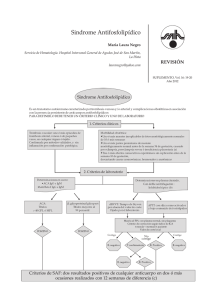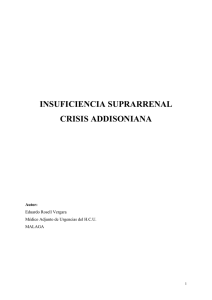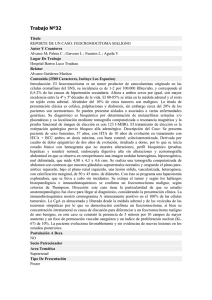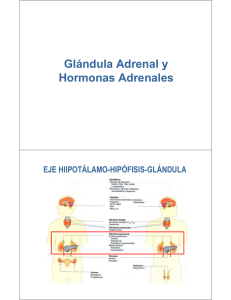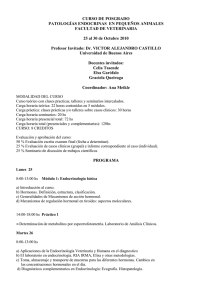Intratesticular heterotopic adrenal tissue in a patient with Coffin
Anuncio
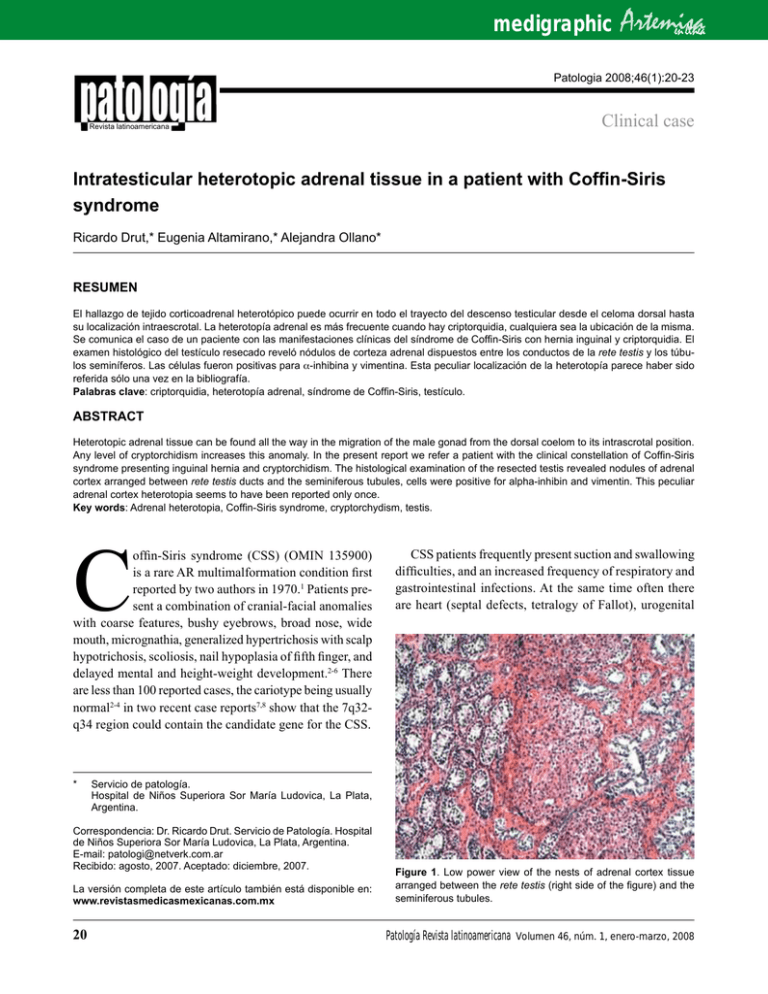
medigraphic Artemisa en línea Patologia 2008;46(1):20-23 Revista latinoamericana Clinical case Intratesticular heterotopic adrenal tissue in a patient with Coffin-Siris syndrome Ricardo Drut,* Eugenia Altamirano,* Alejandra Ollano* RESUMEN El hallazgo de tejido corticoadrenal heterotópico puede ocurrir en todo el trayecto del descenso testicular desde el celoma dorsal hasta su localización intraescrotal. La heterotopía adrenal es más frecuente cuando hay criptorquidia, cualquiera sea la ubicación de la misma. Se comunica el caso de un paciente con las manifestaciones clínicas del síndrome de Coffin-Siris con hernia inguinal y criptorquidia. El examen histológico del testículo resecado reveló nódulos de corteza adrenal dispuestos entre los conductos de la rete testis y los túbulos seminíferos. Las células fueron positivas para a-inhibina y vimentina. Esta peculiar localización de la heterotopía parece haber sido referida sólo una vez en la bibliografía. Palabras clave: criptorquidia, heterotopía adrenal, síndrome de Coffin-Siris, testículo. ABSTRACT Heterotopic adrenal tissue can be found all the way in the migration of the male gonad from the dorsal coelom to its intrascrotal position. Any level of cryptorchidism increases this anomaly. In the present report we refer a patient with the clinical constellation of Coffin-Siris syndrome presenting inguinal hernia and cryptorchidism. The histological examination of the resected testis revealed nodules of adrenal cortex arranged between rete testis ducts and the seminiferous tubules, cells were positive for alpha-inhibin and vimentin. This peculiar adrenal cortex heterotopia seems to have been reported only once. Key words: Adrenal heterotopia, Coffin-Siris syndrome, cryptorchydism, testis. offin-Siris syndrome (CSS) (OMIN 135900) is a rare AR multimalformation condition first reported by two authors in 1970.1 Patients present a combination of cranial-facial anomalies with coarse features, bushy eyebrows, broad nose, wide mouth, micrognathia, generalized hypertrichosis with scalp hypotrichosis, scoliosis, nail hypoplasia of fifth finger, and delayed mental and height-weight development.2-6 There are less than 100 reported cases, the cariotype being usually normal2-4 in two recent case reports7,8 show that the 7q32q34 region could contain the candidate gene for the CSS. C CSS patients frequently present suction and swallowing difficulties, and an increased frequency of respiratory and gastrointestinal infections. At the same time often there are heart (septal defects, tetralogy of Fallot), urogenital * Servicio de patología. Hospital de Niños Superiora Sor María Ludovica, La Plata, Argentina. Correspondencia: Dr. Ricardo Drut. Servicio de Patología. Hospital de Niños Superiora Sor María Ludovica, La Plata, Argentina. E-mail: patologi@netverk.com.ar Recibido: agosto, 2007. Aceptado: diciembre, 2007. La versión completa de este artículo también está disponible en: www.revistasmedicasmexicanas.com.mx 20 Figure 1. Low power view of the nests of adrenal cortex tissue arranged between the rete testis (right side of the figure) and the seminiferous tubules. Patología Revista latinoamericana Volumen 46, núm. 1, enero-marzo, 2008 Intratesticular heterotopic adrenal tissue in a patient with Coffin-Siris syndrome Figure 2. Higher power of figure 1 where two types of cortical cells can be recognized that of glomerular and fascicular layers. Figure 3. Alpha-inhibin positivity of the ectopic adrenocortical cells. The reactivity is less intense than that of Sertoli cells. (chryptorchidia, hypospadias, uterus agenesis), and kidney (crossed ectopia, fused ectopia, hypoplasia) malformations.9 The syndrome has also been reported in association with diaphragmatic hernia10 biotinidase deficiency,11 and hypoglycemia.12 There seem to be no description of testicular lesions in the CSS. We report the finding of adrenal cortex heterotopia in an undescended testis of a patient with CSS. lumbar kyphoscoliosis. The phenotype and the clinical data of the history were consistent with the diagnosis of CSS. At age 3.5 years (05/93) surgical correction of the inguinal hernias was done together with resection of the right testes that was found to be hypoplastic at the inguinal region. The left testis was absent. CASE REPORT The testis size was 4x3x3 mm. Histological examination disclosed the presence of several small collections of epithelial cells readily identifiable as representing the glomerular and fascicular layers of adrenocortical tissue. The patient had a long medical history with evidences of disease since the perinatal period moment at which several external and internal malformations were noticed. Cariotype, including G-banding, was normal. At age 28 months (04/92) an evaluation at the Genetic Clinic showed: weight, height and cephalic perimeter at P3, diffuse hypertrichosis, rounded head, flat occipital, scant scalp hair, small and narrow frontal region, flat supraorbital arch, triangular eyebrows, horizontal palpebral fissure, small malar bones, anteverted narines, triangular filtrum, coarse lips, the upper protruding over the lower, higharched palate, micrognathia, low set and dorsaly-rotated ears, protruding antihelix, folded helix, short neck, wide thorax, widely-set mamillae, hipoplastic nails in 5th finger, transverse palmar crease, feets with nail hypoplasia in the 5th toe, psychomotor delay, difficulties in suction and swallowing, urinary malformations (paraurethral diverticulum, hypoplasia of left kidney associated with vesico-ureteral reflux grade 3-4), bilateral inguinal hernia, and dorsoPatología Revista latinoamericana Volumen 46, núm. 1, enero-marzo, 2008 PATHOLOGY FINDINGS Figure 4. Ectopic adrenocortical cells with focal positivity for vimentin. 21 Drut R y col. These groups of adrenal cortex cells were arranged deep inside the testis between the rete testis and the seminiferous tubules (figures 1 and 2). The latter contained rare spermatogonia and no Leydig cells were found at the interstitial tissue. The epididymis and vas deferens were normal. Restricted immunohistochemical study proved the cells to be positive for alpha-inhibin (less intensity than adjacent Sertoli cells) (figure 3), vimentin (50% of the cells) (figure 4) and keratin (AE1/AE3) (less than 10% of the cells), as well as negative for low-molecular weight keratin (CAM 5.2) (figure 5). The immunohistochemical findings in present case are on line with the reported immunoreactivity of adrenal cortex cells.20-22 REFERENCES 1. 2. 3. 4. 5. 6. 7. 8. 9. 10. Figure 5. Low-molecular weight keratin immunoreactivity appears restricted to the rete testis cells. 11. DISCUSSION 12. Ectopic adrenal cortex tissue has been referred repeatedly as being found adjacent to the vas deferens, epididymis and testis, particularly in patients with cryptorchidism.1315 However, it has rarely been described as to be present within the gonad. One report mentions the same peculiar spot as the one recognized in present patient that is between the rete testis and the rest of the organ. This patient was an adult with undescended testis but no evidences of CSS.16 So, the adrenal cortex heterotopia in our patient may have resulted an epiphenomenon related to the inguinal hernircryptorchidism or, being so extremely unusual, a peculiar developmental abnormality related to CSS. Recent papers favoring the existence of a common primordium for the adrenal gland and gonad17-19 help to explain the occurrence of adrenal cortex ectopia all the way from the dorsal coelom to the gonadal tissue itself. 13. 22 14. 15. 16. 17. 18. 19. Coffin GS, Siris E. Mental retardation with absent fifth fingernail and terminal phalanx. Am J Dis Child 1970;119(5):433-9. Carey JC, Hall BD. The Coffin-Siris syndrome: five cases including two siblings. Am J Dis Child 1978;132(7):667-71. DeBassio WA, Kemper TL, Knoefel JE. Coffin-Siris syndrome. Neuropathologic findings. Arch Neurol 1985;42(4):350-3. Weiswasser WH, Hall BD, Delavan GW, Smith DW. Coffin-Siris syndrome. Two new cases. Am J Dis Child 1973;125(6):83840. Tunnessen WW, McMillan JA, Levin MB. The Coffin-Siris syndrome. Am J Dis Child 1978;132(4):393-5. Aravena C, Castillo T, Villaseca G. Síndrome de Coffin-Siris: 2 casos clínicos y revisión de la literatura. Rev Chil Pediat 2001;72:224-9. McGhee EM, Klump CJ, Bitts SM, Cotter PD, Lammer EJ. Candidate region for Coffin-Siris syndrome at 7q32-34. Am J Med Genet 2000;93(3):241-3. McPherson EW, Laneri G, Clemens MM, Kochmar SJ, Surti U. Apparently balanced t(1;7)(q21.3;q34) in an infant with Coffin-Siris syndrome. Am J Med Genet 1997;71(4):430-3. Fleck BJ, Pandya A, Vanner L, Kerkering K, Borhrtha J. CoffinSiris syndrome: review and presentation of new cases from a questionnaire study. Am J Med Genet 2001;99(1):1-7. Delvaux V, Moerman P, Fryns JP. Diaphragmatic hernia in the Coffin-Siris syndrome. Genet Couns 1998;9(1):45-50. Burlina A, Sherwood W, Zacchello F. Partial biotinidase deficiency associated with Coffin Siris syndrome. Eur J Pediatr 1990;149(9):628-9. Imaizumi K, Nakamura M, Masuno M, Makita Y, Kuroki Y. Hypoglycemia in Coffin-Siris syndrome. Am J Med Genet 1995;59(1):49-50. Ozel SK, Kazez A, Akpolat N. Presence of ectopic adrenocortical tissues in inguinoscrotal region suggests an association with undescended testis. Pediatr Surg Int 2007;23(2):171-5. Roggia A, Marandola P, Broggini P, Bono P, de Francesco O, Rovati L. Ectopic adrenal cortex tissue in the spermatic cord: clinico-surgical implications. Arch Esp Urol 1991;44(10):11656. Finkbeiner AE, DeRidder PA, Ryden SE. Splenic-gonadal fusion and adrenal cortical rest associated with bilateral cryptorchism. Urology 1977;10(4):337-40. Czaplicki M, Bablok L, Kuzaka B, Janczewski Z. Heterotopic adrenal tissue. Int Urol Nephrol 1985;17(2):177-81. Val P, Jeays Ward K, Swain A. Identification of a novel population of adrenal-like cells in the mammalian testis. Dev Biol 2006;299(1):250-6. Morohashi K. The ontogenesis of the steroidogenic tissues. Genes Cells 1997;2(2):95-106. Hatano O, Takakusu A, Nomura M, Morohashi K. Identical origin of adrenal cortex and gonad revealed by expression profiles of Ad4BP/SF-1. Genes Cells 1996;1(7):663-7. Patología Revista latinoamericana Volumen 46, núm. 1, enero-marzo, 2008 Intratesticular heterotopic adrenal tissue in a patient with Coffin-Siris syndrome 20. Cho EY, Ahn GH. Immunoexpression of inhibin alpha-subunit in adrenal neoplasms. Appl Immunohistochem Mol Morphol 2001;9(3):222-8. 21. McCluggage WG, Burton J, Maxwell P, Sloan JM. Immunohistochemical staining of normal, hyperplastic, and neoplastic adrenal cortex with a monoclonal antibody against alpha inhibin. J Clin Pathol 1998;51(2):114-6. 22. Carney JA. Adrenal gland. In: Sternberg SS, ed. Histology for pathologists. 2nd ed., Philadelphia: Lippincott-Raven. 1997;p:1125. Virus del papiloma humano. Una versión para todos Autor: José de Jesús Curiel Valdés Tamaño: 14 x 21 cm Páginas: 80 Editado por: Elsevier Masson Doyma México, S. A. País: México Edición: primera, 2006. El VPH es el principal virus oncógeno para nuestra especie, según la OMS ocurren cerca de 500 mil muertes por cáncer del cuello uterino y otros sitios, relacionados con este virus (6% de todos los cánceres, ¡uno de cada 20 casos!). En México mueren cerca de 4,000 mujeres al año por cáncer cervicouterino relacionado con la infección de este virus (la segunda causa de muerte por cáncer en mexicanas). El propósito de esta publicación es informar de la manera más amplia y sencilla posible sobre el VPH. Patología Revista latinoamericana Volumen 46, núm. 1, enero-marzo, 2008 23
